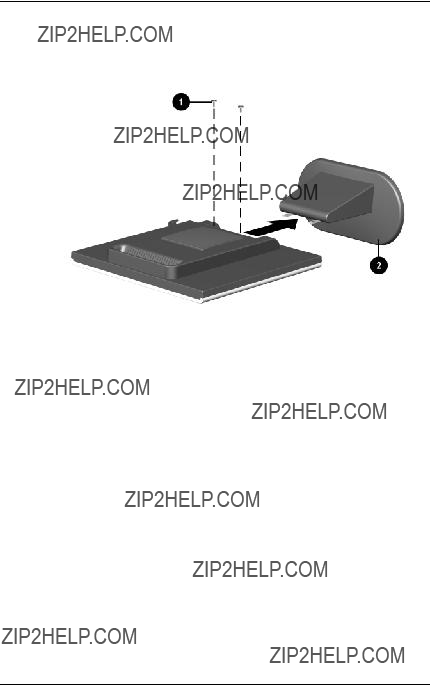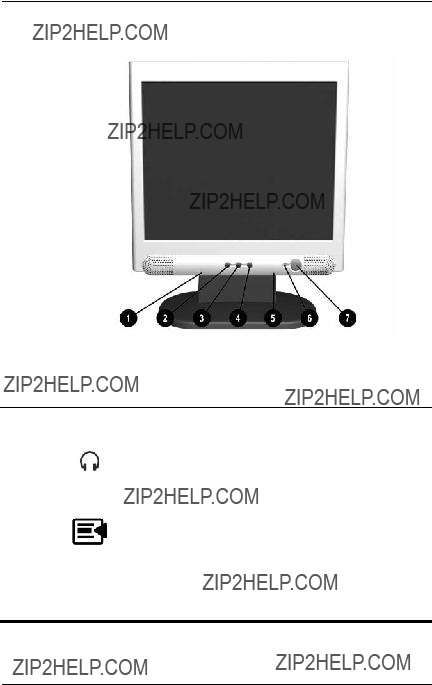b
Reference Guide
Compaq 5017 Flat Panel Monitor
Document Part Number: 266985-001
March 2002
?? 2002 Compaq Computer Corporation.
Compaq, the Compaq logo are trademarks of Compaq Information Technologies Group, L.P.
Microsoft, MS-DOS, Windows, Windows NT are trademarks of Microsoft Corporation in the United States and other countries.
All other product names mentioned herein may be trademarks of their respective companies.
Compaq shall not be liable for technical or editorial errors or omissions contained herein. The information in this document is provided ???as is??? without warranty of any kind and is subject to change without notice. The warranties for Compaq products are set forth in the express limited warranty statements accompanying such products. Nothing herein should be construed as constituting an additional warranty.
Compaq service tool software, including associated documentation, is the property of and contains confidential technology of Compaq Computer Corporation. Service customer is hereby licensed to use the software only for activities directly relating to the delivery of, and only during the term of, the applicable services delivered by Compaq or its authorized service provider. Customer may not modify or reverse engineer, remove, or transfer the software or make the software or any resultant diagnosis or system management data available to other parties without Compaq???s or its authorized service provider???s consent. Upon termination of the services, customer will, at Compaq???s or its service provider???s option, destroy or return the software and associated documentation in its possession.
??CAUTION: Text set off in this manner indicates that failure to follow directions could result in damage to equipment or loss of information.
??WARNING: Text set off in this manner indicates that failure to follow directions could result in bodily harm or loss of life.
Reference Guide
First Edition (March 2002) Part Number: 266985-001

1
Introduction
Product Features
Your flat panel monitor has an active matrix, thin-film transistor (TFT), liquid crystal display (LCD). The monitor features include the following:
???15-inch (38.1 cm) viewable area display.
???1024 x 768 resolution, plus full-screen support for lower resolutions.
???Wide viewing angle to allow viewing from a sitting or standing position, or moving side-to-side.
???Removable base for flexible mounting solutions.
???Plug and play capability if supported by your system.
???On-Screen Display (OSD) adjustments in six different languages: English, Dutch, French, German, Italian, and Spanish for ease of set-up and screen optimization.
???CD-ROM includes an information file (INF), Image Color Matching file (ICM), the Compaq LCD Display Assistant setup and configuration utility, the Compaq Display LiteSaver utility, and product documentation.
???Programmable sleep mode timer.
???Energy Saver feature for Energy Star compliance.
???Security lock slot
???AssetControl
???Compliant with the following regulated specifications:
???EPA ENERGY STAR
???European Union CE Directives
???Swedish MPR II 1990
???Swedish TCO '99 (select models)
2
Safety and Maintenance
Guidelines
Safety Guidelines
Power Requirements
Refer to the ???Power Cord Set Requirements??? section in ???Agency Regulatory Notices,??? for information on the correct power cord set for this device.
Important Safety Information
??WARNING: To reduce the risk of electric shock or damage to your equipment, do not disable the power cord grounding feature. This equipment is designed to be connected to a grounded (earthed) power outlet that is easily accessible to the operator. The grounding plug is an important safety feature.
??WARNING: For your safety, be sure that the power outlet you plug the power cord into is easily accessible and located as close to the equipment as possible. When you need to disconnect the power to the equipment, unplug the power cord from the power outlet by grasping the plug firmly. Never pull on the cord.

Safety and Maintenance Guidelines
??CAUTION: For the protection of your monitor, as well as your computer, connect all power cords for your computer and its peripheral devices (such as a monitor, printer, scanner) to some form of surge protection device such as a power strip or Uninterruptible Power Supply (UPS). Not all power strips provide surge protection; the power strips must be specifically labeled as having this ability. Use a power strip whose manufacturer offers a Damage Replacement Policy so you can replace your equipment if surge protection fails.
Maintenance Guidelines
To enhance the performance and extend the life of your monitor, use the following guidelines:
???Do not open your monitor cabinet or attempt to service this product yourself. Adjust only those controls that are covered in the operating instructions. If your monitor is not operating properly or has been dropped or damaged, contact your Compaq authorized dealer, reseller, or service provider.
???Adjust only those controls that are discussed in the operating instructions.
???Place your monitor at least 3 inches (76 mm) away from walls or other enclosures.
???Use only a power source and connection appropriate for this monitor, as indicated on the label/back plate of the monitor.
???Be sure the total ampere rating of the products connected to the outlet does not exceed the current rating of the electrical outlet, and the total ampere rating of the products connected to the cord does not exceed the rating of the cord. Look on the power label to determine the ampere rating (AMPS or A) for each device.
???Install your monitor near an outlet that you can easily reach. Disconnect the monitor by grasping the plug firmly and pulling it from the outlet. Never disconnect the monitor by pulling the cord.

Safety and Maintenance Guidelines
???Turn your monitor off when not in use. You can substantially increase the life expectancy of your monitor by using a screen saver program and turning off monitor when not in use.
???Unplug your monitor from the wall outlet before cleaning. Do not use liquid cleaners or aerosol cleaners. Use a damp cloth for cleaning. If the screen requires additional cleaning, use an antistatic screen cleaner.
??CAUTION: Do not use benzene, thinner, ammonia, or any other volatile substances to clean your monitor or the screen. These chemicals may damage the cabinet finish as well as the screen.
???Slots and openings in the cabinet are provided for ventilation. These openings must not be blocked or covered. Never push objects of any kind into cabinet slots or other openings.
???Do not drop your monitor or place it on an unstable surface.
???Do not allow anything to rest on the power cord. Do not walk on the cord.
???Keep your monitor in a well-ventilated area, away from excessive light, heat or moisture. Keep your monitor away from high-capacity transformers, electric motors, and other devices with strong magnetic fields.
Safety and Maintenance Guidelines
3
Installation
Monitor Setup
Before installing your monitor, place it in a convenient, well-ventilated location near your computer.
1.Turn off the power to your computer and other peripheral devices.
2.Connect the monitor signal cable to the video connector 1 on the rear panel of the monitor.
3.Place the monitor signal cable into the clip 2 on the back of the monitor.
4.Connect the monitor audio cable to the audio connector 3 on the rear panel of the monitor. (select models only, cable not shown in illustration)
5.Connect the AC power adapter cable to the power connector 4 on the rear panel of the monitor.
6.Connect the video signal cable to the video connector 5 on the rear panel of the computer.
7.Connect the audio cable to the audio connector 6 on the rear panel of the computer. (select models only, cable not shown in illustration)
8.Connect the AC power cord to the AC adapter 7.
9.Connect the power cable 8 to an electrical wall outlet.
Installation
??WARNING: To reduce the risk of electric shock or damage to your equipment:
???Do not disable the power cord grounding plug. The grounding plug is an important safety feature.
???Plug the power cord into a grounded (earthed) electrical outlet that is easily accessible at all times.
???Disconnect power from the monitor by unplugging the power cord from the electrical outlet.
???Do not place anything on power cords or cables. Arrange them so that no one may accidentally step on or trip over them. Do not pull on a cord or cable. When unplugging from the electrical outlet, grasp the cord by the plug.
???For security purposes, this monitor has been fitted with a slot for use with a security cable lock that can be purchased separately at most computer stores.

Installation
???After you turn on the monitor, install the Compaq LCD Display Assistant utility included on the CD-ROM. Use the on-screen instructions to adjust the picture quality of your monitor. To install this utility, follow the instructions on the ???Configuring Your Compaq LCD Monitor??? card located in the Program License Agreement packet.
Important: Always activate a screen saver program, the programmable sleep timer, the Compaq Display LiteSaver utility, or turn off the monitor when it is not in use for a prolonged period of time. All LCD monitors that display the same static image on screen for a prolonged period of time may exhibit screen image retention. Note that image retention is not a permanent condition and will fade over a period of time. Image retention is a condition that may occur on all LCD screens.
Monitor Base Removal (Optional)
If you choose to mount the monitor onto a swing arm or other mounting fixture, you must remove the base from the monitor.
??CAUTION: Before beginning to disassemble the monitor, be sure the monitor is turned off and the power and signal cables are both disconnected.
To remove the base from the monitor, complete the following steps:
1.Lay the front bezel down on a soft area to prevent it from getting scratched, defaced, or broken.
2.Remove the two screws 1 from the back of the monitor as shown in the following illustration.
3.Remove the base 2 from the monitor by pushing the base away from the monitor.

4
Operation
Information Files
The CD-ROM included with this monitor contains two information files to be installed onto your computer; an .INF file and an .ICM file.
The .INF file defines monitor resources and provides specifications used by most operating systems to install support software for certain hardware devices. The .INF file ensures monitor compatibility and optimization with your computer???s graphics adapter. INF files are downloadable by clicking on: www.compaq.com/products/monitors/index.html and selecting the desired monitor.
The .ICM file provides color matching consistency from monitor screen to printer and is activated from within graphics programs that have this feature.
To install these files on your computer:
1.Insert the Software and Reference Guide CD-ROM in your computer's optical drive.
2.When the CD-ROM menu launches, select Install INF and ICM Files.
3.To get the latest .INF and .ICM files, download them from the Compaq Web site. Access http://www.compaq.com/support/files/monitors/index.html and select your monitor model to download the appropriate files.
*Sleep Timer enables you to set a time for the monitor to power on and power off at the same time every day. It eliminates the need to turn off the monitor at the end of the day and conserves energy. To set this mode, refer to the Sleep Timer in the on-screen display. Note that the time is displayed in a 24 hour clock format. For example, 1:15 p.m. displays as 13 hours 15 minutes.
On-Screen Display
The On-Screen Display (OSD) adjusts the screen image based on your viewing preferences. To access the OSD, do the following:
1.If the monitor is not already on, press the Power button to turn on the monitor.
2.Press the Select button to display the On-Screen Display menu. For a description of the icons that appear on the screen, see ???On-Screen Display Functions??? later in this chapter.
Operation
3.To move to a function, press the Right-Adjustment or Left-Adjustment button on the front panel of your monitor until the function is highlighted.
4.Press the Select button on the monitor choose the function.
5.The adjustment window displays. Press the Right-Adjustment or Left-Adjustment buttons to increase (Right) or decrease (Left) the level of adjustment.
6.Press Select to save the new adjustment.
7.To exit the On-Screen Display, select the Exit icon and press the Select button once.
On-Screen Display Functions
Use the Right-Adjustment and Left-Adjustment buttons found on the front control panel of your monitor to adjust these functions:
Operation
How to Adjust Settings
1.To launch the on-screen display menu, complete the following:
???Basic Main Menu: To display the Basic Main Menu, press the Select button on the monitor front panel.
Main Menu
Brightness
Contrast
Auto Adjustment
Advanced Menu
Exit
???Advanced Main Menu: Select ???Advanced Menu??? from the Basic Main Menu to display the Advanced Main Menu shown below.

Operation
Note: After the Advanced Main Menu has been selected, it remains the default on-screen display each time the monitor is powered on until the Basic Main Menu option is selected again.
2.To select an item from the Basic Main Menu, scroll down and highlight an item by pressing the Left Adjustment (-) button located on the monitor front panel. To reverse or back up, press the Right Adjustment (+) button.
3.Highlight your choice and press the Select button again.
4.Adjust the Advanced Main Menu displays using the same procedure as the first level.
Note: The advanced menus for Brightness and Contrast display an adjustment screen. Use the Left Adjustment (-) button to decrease and the Right Adjustment (+) button to increase the screen brightness and contrast.
5.Access the third level by selecting a function and pressing the Menu button. Adjust the third level menu displays using the same procedures as the second level.
6.To exit from the on-screen menu, select Exit from the Advanced Main Menu. If the display is a second or third-level menu, select Save and Return or Cancel, then select Exit from the Advanced Main Menu.
The on-screen display is easy to use, just follow the instructions on the screen.
Monitor Messages
Special messages will appear on the monitor screen when identifying the following monitor conditions:

Operation
???Input Signal Out of Range: Indicates the monitor is unable to access or fully support the provided input signal.
???Going to Sleep: Indicates the screen display is entering a sleep mode.
???Check Video Cable: Indicates the video cable may not be plugged into the computer or the computer may not be turned on.
???OSD Lock???The OSD can be enabled or disabled by pressing and holding the Menu button on the front panel for 10 seconds. If the OSD is disabled, the warning message ???OSD Lock??? displays for five seconds.
Energy Saver Feature
When the monitor is in its normal operating mode, the monitor utilizes less than 45 watts of power and the Power LED is green.
The monitor also supports a reduced power state. The reduced power state will be entered into if the monitor detects the absence of either the horizontal sync signal and/or the vertical sync signal. Upon detecting the absence of these signals, the monitor screen is blanked, the backlight is turned off, and the Power LED is turned amber. When the monitor is in the reduced power state, the monitor will utilize less than 5 watts of power. There is a brief warm up period before the monitor will return to its normal operating mode.
Refer to your computer manual for instructions on setting energy saver features (sometimes called power management features).
???The above energy saver feature only works when connected to computers that have energy saver features.

Operation
By selecting settings in the monitor???s Energy Saver utility, you can also program the monitor to enter into the reduced power state at a predetermined time. When the monitor???s Energy Saver utility causes the monitor to enter the reduced power state, the Power LED blinks amber.
Sleep Timer Mode
The Sleep Timer mode is an energy-saving feature that enables you to set a time for the monitor to power on and off at the same time every day. This also extends the life of the backlight bulbs in the monitor. The Sleep Timer has five settings:
???Set Current Time
???Set Sleep Time
???Set On Time
???Timer: On/Off
???Sleep Now
To set the timer:
1.Press the Select button on the monitor front panel to display the Advanced Menu.
2.Scroll down and highlight Management.
3.Press the Select button to select Management.
4.Scroll down and highlight and select Sleep Timer > Set Current Time.
???You must set the current local time before you reset the time for Sleep Time or On Time. Note that the time is displayed in a 24 hour clock format. For example, 1:15 p.m. displays as 13 hours
15minutes.
5.Press the Select button once to enter the adjustment mode for hours.

Operation
6.Press the Left Adjustment or Right Adjustment buttons to adjust the hour.
7.Press the Select button again to enter the time for minutes.
8.Press the Left Adjustment or Right Adjustment buttons to adjust the minutes.
9.Press the Select button to lock in the time chosen.
10.After setting the current time, the highlight automatically skips to Set Sleep Time hours. Repeat steps 6 through 9 to set Sleep Time.
11.If you do not want to set Sleep Time, press the Select button twice, then select Save and Return to exit the menu.
12.After setting Sleep Time, the highlight automatically skips to Set On Time hours. Repeat steps 6 through 9 to set On Time.
13.Set the Timer mode to On to activate the Sleep Timer settings.
14.When you are finished, select Save and Return to exit the menu.
The fifth selection, Sleep Now, turns the monitor backlights off immediately and stays in sleep mode until the next On Time activates or a monitor button is pressed.
Adjusting Screen Quality
Allow the monitor to warm up for 20 minutes before performing the following procedures.
The Auto Adjustment feature in the OSD automatically fine-tunes the image quality each time a new video mode is utilized. If additional improvement is desired, select "Auto Adjust" in the Basic Menu.

Operation
For more precise adjustments, use the Compaq LCD Display Assistant utility included on the CD-ROM. This utility graphically illustrates how to adjust the Clock and Clock Phase controls explained in the Optimizing Digital Conversion section below.
Optimizing Digital Conversion
This monitor contains advanced circuitry that allows the flat panel screen to function like a standard monitor. Two controls in the on-screen display can be adjusted to improve image performance: Clock and Clock Phase.
Important: The Clock must first be set correctly since the Clock Phase settings are dependent on the main Clock setting.
???Clock???Increase/decrease the value to minimize any vertical bars or stripes visible on the screen background.
???Clock Phase???Increase/decrease the value to minimize video distortion or video jitter.
???When adjusting the Clock and Clock Phase values, if the monitor images become distorted, continue adjusting the values until the distortion disappears. To restore the factory settings, select Yes from the Factory Reset menu in the on-screen display.
User Modes
The video controller signal may occasionally call for a mode that is not preset if:
???You are not using a Compaq standard graphics adapter.
???You are not using a preset mode.
Operation
If this occurs, you may need to readjust the parameters of the monitor screen by using the on-screen display. User changes can be made to any or all of these modes and saved in memory. The monitor automatically stores the new setting, then recognizes the new mode just as it does a preset mode. In addition to the 11 factory preset modes, there are eight user modes that can be entered and stored.
A
Troubleshooting
Solving Common Problems
The following table lists possible problems, the possible cause of each problem, and the recommended solutions.
Leave at least 3 inches (76 mm) of ventilation space around the monitor, and do not place objects on top of the monitor.
Using the World Wide Web
Support services are available on the Internet through the Compaq Support Forum. You can either browse the postings as a guest, or register as a user and submit your own questions. Compaq responds to questions within one business day.
To access the Compaq Support Forum, go to the Compaq Web site at: http://www.compaq.com
Troubleshooting
Preparing to Call Technical Support
If you cannot solve a problem using the troubleshooting tips in this section, you may need to call technical support. Have the following information available when you call:
???The monitor
???Monitor model number
???Serial number for the monitor
???Purchase date on invoice
???Conditions under which the problem occurred
???Error messages received
???Hardware configuration
???Hardware and software you are using
B
Specifications
Compaq 5017 Flat Panel Monitor
Technical Specifications
Specifications
Technical Specifications
5 to 35 o C -20 to +60 o C
Display Resolutions
The display resolutions listed below are the most commonly used modes and are set as factory defaults. This monitor automatically recognizes these preset modes and they will appear properly sized and centered on the screen.
Factory Preset Display Modes
Specifications
Factory Preset Display Modes

C
Agency Regulatory Notices
Federal Communications Commission
Notice
This equipment has been tested and found to comply with the limits for a Class B digital device, pursuant to Part 15 of the FCC Rules. These limits are designed to provide reasonable protection against harmful interference in a residential installation. This equipment generates, uses, and can radiate radio frequency energy and, if not installed and used in accordance with the instructions, may cause harmful interference to radio communications. However, there is no guarantee that interference will not occur in a particular installation. If this equipment does cause harmful interference to radio or television reception, which can be determined by turning the equipment off and on, the user is encouraged to try to correct the interference by one or more of the following measures:
???Reorient or relocate the receiving antenna.
???Increase the separation between the equipment and the receiver.
???Connect the equipment into an outlet on a circuit different from that to which the receiver is connected.
???Consult the dealer or an experienced radio or television technician for help.

Agency Regulatory Notices
Modifications
The FCC requires the user to be notified that any changes or modifications made to this device that are not expressly approved by Compaq Computer Corporation may void the user's authority to operate the equipment.
Cables
Connections to this device must be made with shielded cables with metallic RFI/EMI connector hoods to maintain compliance with FCC Rules and Regulations.
Declaration of Conformity for Products Marked with FCC Logo, United States Only
This device complies with Part 15 of the FCC Rules. Operation is subject to the following two conditions: (1) this device may not cause harmful interference, and (2) this device must accept any interference received, including interference that may cause undesired operation.
For questions regarding your product, contact:
Compaq Computer Corporation
P. O. Box 692000, Mail Stop 530113
Houston, Texas 77269-2000
Or, call - 1-800- 652-6672 (1-800-OK COMPAQ)
For questions regarding this FCC declaration, contact:
Compaq Computer Corporation
P. O. Box 692000, Mail Stop 510101
Houston, Texas 77269-2000
Or, call - (281) 514-3333
To identify this product, refer to the Part, Series, or Model number found on the product.
Agency Regulatory Notices
Canadian Notice
This Class B digital apparatus meets all requirements of the Canadian Interference-Causing Equipment Regulations.
Avis Canadien
Cet appareil num??rique de la classe B respecte toutes les exigences du R??glement sur le mat??riel brouilleur du Canada.
European Union Notice
Products with the CE Marking comply with both the EMC Directive (89/336/EEC) and the Low Voltage Directive (73/23/EEC) issued by the Commission of the European Community.
Compliance with these directives implies conformity to the following European norms (in brackets are the equivalent international standards):
???EN55022 (CISPR 22) - Electromagnetic Interference
???EN55024 (IEC61000-4-2,3,4,5,6,8,11) - Electromagnetic Immunity
???EN61000-3-2 (IEC61000-3-2) - Power Line Harmonics
???EN61000-3-3 (IEC61000-3-3) - Power Line Flicker
???EN60950 (IEC950) - Product Safety
Japanese Notice

Agency Regulatory Notices
EPA Energy Star Compliance
Monitors that are marked with the Energy Star Logo meet the requirements of the EPA Energy Star program. As an Energy Star Partner, Compaq Computer Corporation has determined that this product meets the Energy Star guidelines for energy efficiency. Specific details on using the Energy Saving features can be found in the energy saver or power management section of the computer manual.
Power Cord Set Requirements
The monitor power supply is provided with Automatic Line Switching (ALS). This feature allows the monitor to operate on input voltages between 100-120V or 200-240V.
The power cord set (flexible cord or wall plug) received with the monitor meets the requirements for use in the country where you purchased the equipment.
If you need to obtain a power cord for a different country, you should purchase a power cord that is approved for use in that country.
The power cord must be rated for the product and for the voltage and current marked on the product's electrical ratings label. The voltage and current rating of the cord should be greater than the voltage and current rating marked on the product. In addition, the cross-sectional area of the wire must be a minimum of 0.75 mm?? or 18AWG, and the length of the cord must be between 6 feet (1.8 m) and 12 feet (3.6 m). If you have questions about the type of power cord to use, contact your Compaq authorized service provider.
A power cord should be routed so that it is not likely to be walked on or pinched by items placed upon it or against it. Particular attention should be paid to the plug, electrical outlet, and the point where the cord exits from the product.
D
TCO ???99
You have just purchased a TCO'99 approved and labelled product! Your choice has provided you with a product developed for professional use. Your purchase has also contributed to reducing the burden on the environment and also to the further development of environmentally adapted electronics products.
Why do we have environmentally labelled computers?
In many countries, environmental labelling has become an established method for encouraging the adaptation of goods and services to the environment. The main problem, as far as computers and other electronics equipment are concerned, is that environmentally harmful substances are used both in the products and during their manufacture. Since it is not so far possible to satisfactorily recycle the majority of electronics equipment, most of these potentially damaging substances sooner or later enter nature.

There are also other characteristics of a computer, such as energy consumption levels, that are important from the viewpoints of both the work (internal) and natural (external) environments. Since all methods of electricity generation have a negative effect on the environment (e.g. acidic and climate-influencing emissions, radioactive waste), it is vital to save energy. Electronics equipment in offices is often left running continuously and thereby consumes a lot of energy.
What does labelling involve?
This product meets the requirements for the TCO'99 scheme which provides for international and environmental labelling of personal computers. The labelling scheme was developed as a joint effort by the TCO (The Swedish Confederation of Professional Employees), Svenska Naturskyddsforeningen (The Swedish Society for Nature Conservation) and Statens Energimyndighet (The Swedish National Energy Administration).
Approval requirements cover a wide range of issues: environment, ergonomics, usability, emission of electric and magnetic fields, energy consumption and electrical and fire safety.
The environmental demands impose restrictions on the presence and use of heavy metals, brominated and chlorinated flame retardants, CFCs (freons) and chlorinated solvents, among other things. The product must be prepared for recycling and the manufacturer is obliged to have an environmental policy which must be adhered to in each country where the company implements its operational policy.
The energy requirements include a demand that the computer and/or display, after a certain period of inactivity, shall reduce its power consumption to a lower level in one or more stages. The length of time to reactivate the computer shall be reasonable for the user.
Labelled products must meet strict environmental demands, for example, in respect of the reduction of electric and magnetic fields, physical and visual ergonomics and good usability.

TCO ???99
Below you will find a brief summary of the environmental requirements met by this product. The complete environmental criteria document may be ordered from:
TCO Development
SE-114 94 Stockholm, Sweden
Fax: +46 8 782 92 07
Email (Internet): development@tco.se
Current information regarding TCO'99 approved and labelled products may also be obtained via the Internet, using the address: http://www.tco-info.com/
Environmental Requirements
Flame Retardants
Flame retardants are present in printed circuit boards, cables, wires, casings and housings. Their purpose is to prevent, or at least to delay the spread of fire. Up to 30% of the plastic in a computer casing can consist of flame retardant substances. Most flame retardants contain bromine or chloride, and those flame retardants are chemically related to another group of environmental toxins, PCBs. Both the flame retardants containing bromine or chloride and the PCBs are suspected of giving rise to severe health effects, including reproductive damage in fish-eating birds and mammals, due to the bioaccumulative* processes. Flame retardants have been found in human blood and researchers fear that disturbances in foetus development may occur.
The relevant TCO'99 demand requires that plastic components weighing more than 25 grams must not contain flame retardants with organically bound bromine or chlorine. Flame retardants are allowed in the printed circuit boards since no substitutes are available.

TCO ???99
???Bioaccumulative is defined as substances which accumulate within living organisms.
Cadmium
Cadmium is present in rechargeable batteries and in the colour-generating layers of certain computer displays. Cadmium damages the nervous system and is toxic in high doses. The relevant TCO'99 requirement states that batteries, the colour-generating layers of display screens and the electrical or electronics components must not contain any cadmium.
???Cadmium is a heavy metal that is Bioaccumulative.
Mercury
Mercury is sometimes found in batteries, relays and switches. It damages the nervous system and is toxic in high doses. The relevant TCO'99 requirement states that batteries may not contain any mercury. It also demands that mercury is not present in any of the electrical or electronics components associated with the labelled unit. There is however one exception. Mercury is, for the time being, permitted in the back light system of flat panel monitors as there today is no commercially available alternative. TCO aims on removing this exception when a mercury free alternative is available.
???Mercury is a heavy metal that is Bioaccumulative.
TCO ???99
CFCs (Freons)
The relevant TCO'99 requirement states that neither CFCs nor HCFCs may be used during the manufacture and assembly of the product. CFCs (freons) are sometimes used for washing printed circuit boards. CFCs break down ozone and thereby damage the ozone layer in the stratosphere, causing increased reception on earth of ultraviolet light with e.g. increased risks of skin cancer (malignant melanoma) as a consequence.
Lead
Lead can be found in picture tubes, display screens, solders and capacitors. Lead damages the nervous system and in higher doses, causes lead poisoning. The relevant TCO??99 requirement permits the inclusion of lead since no replacement has yet been developed.
???Lead is a heavy metal that is Bioaccumulative.










































